![]()
![]()
![]()
Use LEFT and RIGHT arrow keys to navigate between flashcards;
Use UP and DOWN arrow keys to flip the card;
H to show hint;
A reads text to speech;
34 Cards in this Set
- Front
- Back
|
ultimate explanation
|
reason that a trait of phenomenon is thought to have evolved; the adaptive advantage of that trait
|
|
|
Which proccess is know as reduction division?
|
meoisis
|
|
|
proximate explanation
|
in biology, the immediate, mechanistic cause of a phenomenon (how it happens)
|
|
|
During the full meoisis process how many cells are created from the original parental cell
|
4
|
|
|
sperm
|
male reproductive cell
|
|
|
egg
|
female reproductive cell
|
|
|
gametogenesis
|
production of gametes (eggs or sperm)
|
|
|
embryo
|
a young developing organism. the stage after fertilization and zygote formation
|
|
|
gametes
|
a haploid reproductive cell that can fuse with another haploid cell to form a zygote. most multicellular eukaryotes have twoo distinct forms of gametes. egg cells and sperm cells. (reproductive cells)
|
|
|
zygote
|
the diploid cell formed by the union of two haploid gametes (egg + sperm). capable of undergoing embryological development to form an adult.
|
|
|
meiosis
|
a type of cell division in which one diploid parent cell produces four haploid reproductive cells (gametes). in meiosis, chromosome pairs synapse and can exchange genes via crossing over.
|
|
|
autosome
|
one of any pair of chromosomes that do not carry the genes that determine gender
|
|
|
gene
|
a section of DNA that encodes information for building a polypeptide or a functional molecule of RNA. influences one or more hereditary traits in an individual
|
|
|
non-sister chromatids
|
the chromosome copies in homologous chromosomes
|
|
|
karyotype
|
the distinctive appearance of all of the chromosomes in an individual, including the number of chromosomes and their length and banding patterns
|
|
|
haploid number
|
the number of different types of chromosomes in a cell. smbolized by n
|
|
|
tetrad
|

synapsed homologous chromsomes
|
|
|
ploidy
|
the number of each type of chromosome present; equivalent to the number of haploid chromosome sets present
|
|
|
allele
|

a particular version of a gene
|
|
|
haploid
|
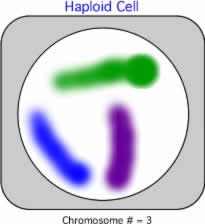
having 1 of each type of chromosome. (n)
|
|
|
diploid
|

having 2 of each type of chromosome. (2n)
|
|
|
meoisis I phases
|

see picture
|
|
|
centromere
|
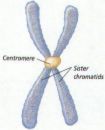
portion of the chromosome where sister chromotids are joined
|
|
|
meoisis II phases
|
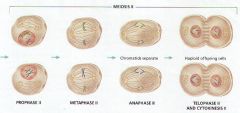
see pic
|
|
|
sister chromatids
|
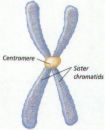
the chromosome copies in a replicated chromosome
|
|
|
homologs
|

homologous chromosomes. in a diploid organism, chromosomes that are similar in size, shape, and gene content. (although genes are the same, alleles may be different)
|
|
|
Chromosome
|
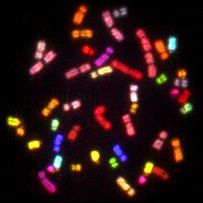
structure made up of DNA and proteins, carries the cell's hereditary information (genes)
|
|
|
phases of mitosis
|

see pic
|
|
|
interphase
|
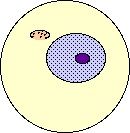
1. Cell matures & carries on normal activities
2. DNA copied & appears as chromatin 3. Nucleolus visible |
|
|
late prophase (mitosis)
|
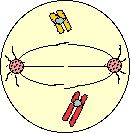
1. Spindle forms with aster at each pole
2. Nuclear membrane & nucleolus disintegrate 3. Centromere of chromosomes attaches to spindle fibers |
|
|
anaphase (mitosis)
|
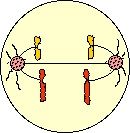
1. Centromeres split apart
2. Homologs move to opposite poles of the cell |
|
|
telophase/cytokinesis (mitosis)
|

1. Nuclear membrane & nucleolus reform
2. Cell pinches into 2 cells in animals 3. In plants, a cell plate separates the 2 new cells |
|
|
early prophase (mitosis)
|
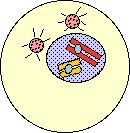
1. Chromosomes condense & become visible
2. Centrioles separate & spindle starts forming |
|
|
metaphase (mitosis)
|

1. Chromosomes line up at the equator of the cell attached to kinetochore fibers of spindle
|

